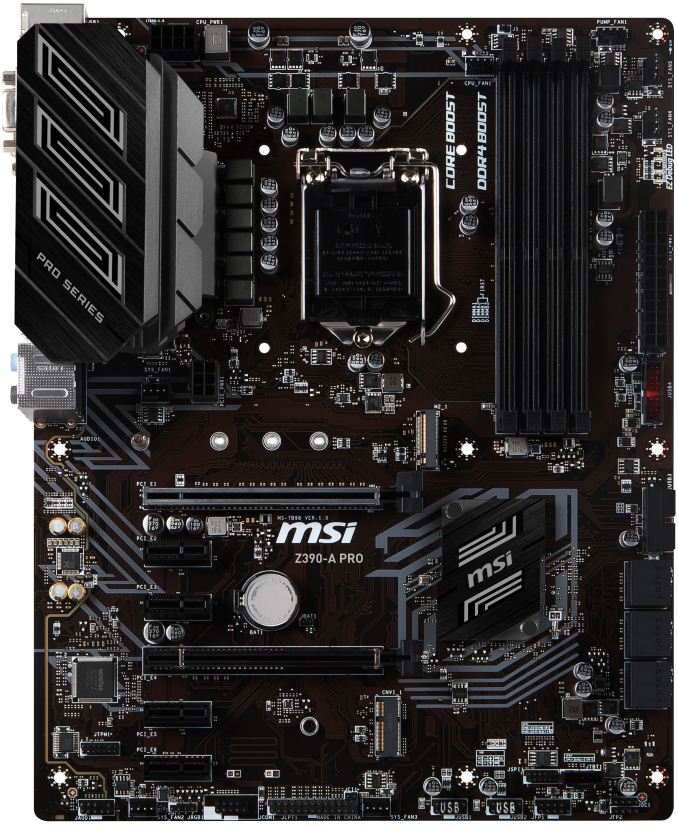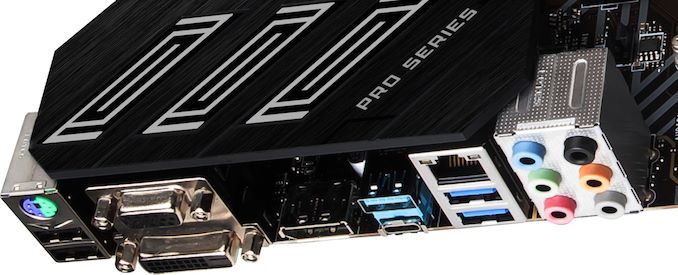Intel Z390 Motherboard Overview: 50+ Motherboards Analyzed
by Ian Cutress & Gavin Bonshor on October 8, 2018 10:53 AM EST- Posted in
- Motherboards
- Intel
- MSI
- Gigabyte
- ASRock
- EVGA
- Asus
- NZXT
- Supermicro
- Z390
MSI Z390-A PRO
The main difference between the MSI Z390-A PRO and the rest of MSI's Z390 product stack is that this board isn't specifically targeted towards gamers. The aesthetics are simple with a coffee colored PCB which does include silver patterning across it; primarily around the edges of the board and around the silver and black heatsinks. The main selling point of the MSI Z390-A PRO is in its value with a good selection of controllers including an Intel I219V Gigabit Ethernet controller and a Realtek ALC892 HD audio codec handling the onboard audio.
On the board are two full-length PCIe 3.0 slots with the top MSI Steel Slot coated slot running at x16 and the second full-length slot operating at x4. Also present is plenty of PCIe 3.0 x1 ports as the Z390-A PRO has four in total. The storage options are pretty basic on the Z390-A PRO with this being the only Z390 MSI board to feature only one PCIe/SATA M.2 slot; this is complemented by a total of six SATA ports with support for RAID 0. 1. 5 and 10 arrays. In terms of memory, the board is packing four RAM slots with support for DDR4--4400 with a maximum capacity of up to 64 GB.
Rear panel connections wise the MSI Z390-A PRO has a USB 3.1 Gen2 Type-A and Type-C port and four USB 2.0 ports; up to two USB 3.0 and four USB 2.0 ports can be made available through the use of internal headers. A total of six 3.5 mm audio jacks are powered by a Realtek ALC892 HD audio codec and a single LAN port controlled by an Intel I219V Gigabit networking chip. The Z390-A PRO is the only MSI board to include a D-Sub video output which seemingly replaces the HDMI and also included is a DisplayPort and DVI-D output.
The MSI Z390-A PRO is the cheapest Z390 motherboard from MSI at launch with a suggested retail price of $140 which all things considered is still quite expensive for chipsets entry-level model. The board makes use of a decent set of controllers which further hikes the price up and it seemingly means users are going to have to look at adding a little more cash to their budget in order to jump onto MSI's Z390 platform; especially compared with the equivalent models when the Z370 chipset debuted.












79 Comments
View All Comments
eastcoast_pete - Thursday, October 11, 2018 - link
Yes, you are correct, at least for H310c chipsets, maybe more (all?). I looked at the digitimes report on Intel outsourcing to TSMC, and that, if correct, would be about chipsets fabbed in 14nm. I wonder if Anadtech could check the 390s from the newest MoBos and sleuth out if they are also a case of "back to the future - 22 is the new 14 at Intel".peterfares - Wednesday, October 10, 2018 - link
Still waiting for someone to make a mini-ITX board with 4x SODIMM slots. The X299 one is interesting combined with a 9800X but I'd rather have the newer architecture with better IPC and clocks.gavbon - Thursday, October 11, 2018 - link
4 x SODIMMs has no performance benefit on Z370/Z390 other than a capacity increase because of the dual channel memory controller. The ASUS Z390 Maximus Gene and Strix Z390-I support the new 32GB double capacity SODIMMs to give more options for mini-ITX users needing more capacity.The X299 ASRock board put 4 x RAM slots on it so it could benefit from the quad channel memory controller
gamingkingx - Friday, October 12, 2018 - link
Gavon understands it..On ITX its all about how you use the space.. It would be sille to have 4 slots for dual channel.
BUT! It would interesting to use only 2x SO-DIMM..
cyrilp - Thursday, October 11, 2018 - link
Some of the asrock boards have 8 SATA3, 3 Ultra M.2 but it's a bit misleading as they share lanes. so you can't use 8 sata3 drivers and 3 m2 ones at the same timegavbon - Thursday, October 11, 2018 - link
Yeah, it's a bit of a pain, but one of the drawbacks of a chipset designed for the desktop. Unfortunately, in that situation, it's one or the other. If I was going to use 8 x SATA drives and 3 x M.2, I would probably be using a HEDT chipset such as X299 or TR4 anywayballsystemlord - Thursday, October 11, 2018 - link
Spelling and grammar corrections. I did not read this whole article. You 2 goofed this one up pretty badly."In the below table a question mark (?) denotes that we currently don't currently have this information available."
Too many currentlys.
"In the below table a question mark (?) denotes that we don't currently have this information available."
"My take on it is that it could be easier to mount a CPU pot for extreme overclockers for some reason, as I'm sure this board is all about the performance marbles and nothing else."
Sound bytes as a sentence (SBAAS). I've very little idea what you were trying to say. Maybe:
"My take on it is that it could be easier to mount a CPU pot for extreme overclockers. For some reason they insist on pots. Or maybe not, as I'm sure this board is all about the performance and nothing else."
"The new gaming themed naming structure consists of three different ranges which make a lot of sense when they deciphered; the MEG is the enthusiast gaming, MPG is performance gaming and the MAG is the arsenal gaming."
Missing "are".
"The new gaming themed naming structure consists of three different ranges which make a lot of sense when they're deciphered; the MEG is the enthusiast gaming, MPG is performance gaming and the MAG is the arsenal gaming."
"The MAG essentially renames the original arsenal range of boards with a name which seems fitting etc rifle mag, a happy coincidence perhaps."
Stray "etc".
"The MAG essentially renames the original arsenal range of boards with a name which seems fitting i.e. rifle mag, a happy coincidence perhaps."
gavbon - Friday, October 12, 2018 - link
Appreciated, updated :)ballsystemlord - Thursday, October 11, 2018 - link
I love your table on "Power Delivery Comparison".But how do you tell how many phases each board has from your table?
E.g. "GIGABYTE Z390 Gaming SLI" has 5+2 ISL69138 but then has 5 ISL6617A doublers leading me to the conclusion that it is a 25 + 2 phase design.
Thanks!
gavbon - Friday, October 12, 2018 - link
I've updated the table to make it more clear :) - The PPaks are dual channel MOSFETs so each of the GIGABYTE boards is running 10 phases, with 5 doublers = 2 phases per channel. This is the data we received directly from GIGABYTE.